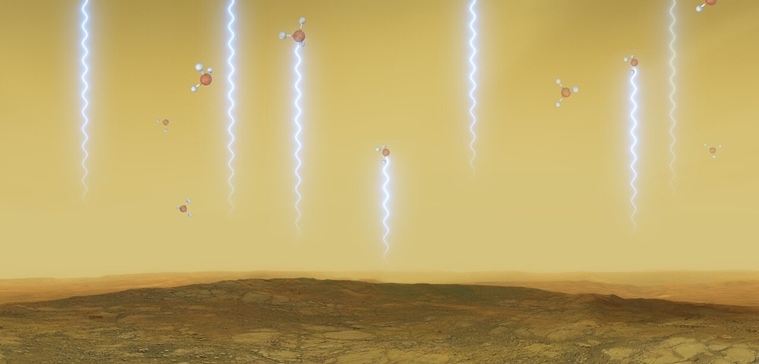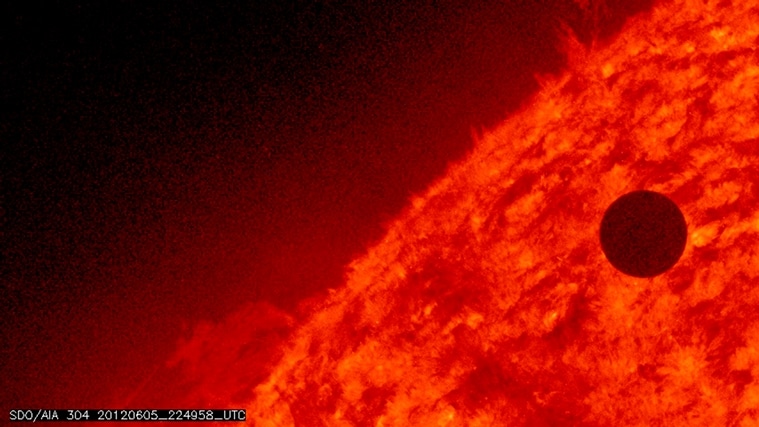
Updated: September 14, 2020 10:34:49 pm
 The presence of phosphine in the atmosphere of Venus is something that was not expected and is “inexplicable”. (NASA / File photo)
The presence of phosphine in the atmosphere of Venus is something that was not expected and is “inexplicable”. (NASA / File photo)
Scientists said Monday they have detected in the acidic clouds of Venus a gas called phosphine that indicates that microbes may inhabit Earth’s inhospitable neighbor, a tantalizing sign of potential life beyond Earth.
The researchers did not discover real life forms, but pointed out that on Earth, phosphine is produced by bacteria that thrive in oxygen-free environments. The international scientific team first detected phosphine using the James Clerk Maxwell telescope in Hawaii and confirmed it using the Atacama Large Millimeter / submillimeter Array (ALMA) radio telescope in Chile.
“I was very surprised, actually surprised,” said astronomer Jane Greaves of Cardiff University in Wales, lead author of the research published in the journal Nature Astronomy.
 This artistic illustration shows the surface and atmosphere of Venus, as well as phosphine molecules. These molecules float in the windswept clouds of Venus at altitudes of 55 to 80 km, absorbing some of the millimeter waves that occur at lower altitudes. (ESO / M. Kornmesser / L. Calcada via Reuters)
This artistic illustration shows the surface and atmosphere of Venus, as well as phosphine molecules. These molecules float in the windswept clouds of Venus at altitudes of 55 to 80 km, absorbing some of the millimeter waves that occur at lower altitudes. (ESO / M. Kornmesser / L. Calcada via Reuters)
The existence of extraterrestrial life has long been one of the fundamental questions of science. Scientists have used probes and telescopes to search for “biosignatures,” indirect signs of life, on other planets and moons in our solar system and beyond.
“With what we currently know of Venus, the most plausible explanation for phosphine, fantastic as it may sound, is life,” said molecular astrophysicist at the Massachusetts Institute of Technology and study co-author Clara Sousa-Silva.
“I must emphasize that life, as an explanation for our discovery, should be, as always, the last resort,” added Sousa-Silva. “This is important because, if it is phosphine and if it is life, it means that we are not alone. It also means that life itself must be very common, and there must be many other inhabited planets throughout our galaxy. “
Phosphine, a phosphorous atom with three hydrogen atoms attached to it, is highly toxic to people.
Ground-based telescopes like the ones used in this research help scientists study the chemistry and other characteristics of celestial objects.
 Brochure image courtesy of NASA showing planet Venus at the beginning of its transit of the Sun, June 5, 2012. (Reuters / NASA / AIA / Solar Dynamics Observatory / Brochure)
Brochure image courtesy of NASA showing planet Venus at the beginning of its transit of the Sun, June 5, 2012. (Reuters / NASA / AIA / Solar Dynamics Observatory / Brochure)
Phosphine was observed at 20 parts per billion in the atmosphere of Venus, a minimal concentration. Greaves said the researchers examined possible non-biological sources such as volcanism, meteorites, lightning and various types of chemical reactions, but none seemed viable. Research continues to confirm the presence of life or find an alternative explanation.
Venus is the closest planetary neighbor to Earth. Similar in structure but slightly smaller than Earth, it is the second planet from the sun. Earth is the third. Venus is shrouded in a thick, toxic atmosphere that traps heat. Surface temperatures reach 880 degrees Fahrenheit (471 degrees Celsius), hot enough to melt lead.
“I can only speculate what life could survive on Venus, if it exists. No life could survive on the surface of Venus, because it is completely inhospitable, even for completely different biochemistry than ours, “said Sousa-Silva. “But long ago, Venus could have had life on its surface, before a runaway greenhouse effect left most of the planet completely uninhabitable.”
THE ACID TEST
Some scientists have suspected that high clouds on Venus, with mild temperatures around 86 degrees Fahrenheit (30 degrees Celsius), could harbor airborne microbes that could withstand extreme acidity. These clouds contain approximately 90% sulfuric acid. Terrestrial microbes could not survive that acidity.
 Data from NASA’s Magellan spacecraft and Pioneer Venus Orbiter is used in an undated composite image of the planet Venus. (NASA / JPL-Caltech / Handout via Reuters)
Data from NASA’s Magellan spacecraft and Pioneer Venus Orbiter is used in an undated composite image of the planet Venus. (NASA / JPL-Caltech / Handout via Reuters)
“If it’s microorganisms, they would have access to some sunlight and water, and maybe they would live in droplets of liquid to prevent dehydration, but they would need some unknown mechanism to protect against acid corrosion,” Greaves said.
On Earth, microorganisms in “anaerobic” environments – ecosystems that do not depend on oxygen – produce phosphine. These include sewer plants, swamps, rice fields, marshes, lake sediments, and the droppings and intestinal tracts of many animals. Phosphine also arises non-biologically in certain industrial settings.
To produce phosphine, terrestrial bacteria take phosphate from minerals or biological material and add hydrogen.
“We have done everything possible to explain this discovery without the need for a biological process. With our current knowledge of phosphine, Venus, and geochemistry, we cannot explain the presence of phosphine in clouds on Venus. That does not mean it is life. It just means that some exotic process is producing phosphine, and our understanding of Venus needs to improve, ”said Clara Sousa-Silva.
Venus should be hostile to phosphine. Its surface and atmosphere are rich in oxygen compounds that would react quickly with phosphine and destroy it.
“Something must be creating the phosphine on Venus as fast as it is being destroyed,” said study co-author Anita Richards, an astrophysicist associated with the University of Manchester in England.
While previous robotic spacecraft visited Venus, a new probe may be needed to confirm life.
“Fortunately, Venus is right next door,” Sousa-Silva said. “So we can literally go and check.”
Express Tech is now on Telegram. Click here to join our channel (@expresstechie) and stay up to date with the latest tech news
📣 The Indian Express is now on Telegram. Click here to join our channel (@indianexpress) and stay up to date with the latest headlines
For the latest tech news, download the Indian Express app.
.